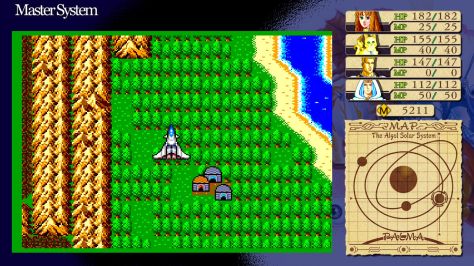
When I begin the process of writing a review for a game, the first thing I do is create a blank Word document and save it. Most of the time, I find writing process arduous and this small act reminds me that when I’m done, I’ll have accomplished something and it will have all been worth it. Well, when I got started on this review, my computer asked if I wanted to create a copy or overwrite the already existing file. It took me a second to realize that I didn’t start a day or two ago; no, it was referring to the review I wrote when I originally played Phantasy Star back in early 2012. I couldn’t help but chuckle and feel a sense of relief: my work was already done!
Now, I hadn’t forgotten about playing the game back then. In fact, the playthrough I just completed was quite nostalgic, as it brought back memories of playing the version included in the Game Boy Advance compilation during my final semesters of college. The minutia of the game had long since escaped me when I started the recent SEGA AGES release for the Switch, but I could still vividly recall sitting outside in the late stages of winter: cold, yet sunny, occupying myself in between classes. Rereading my thoughts on the game from back then, I’m not surprised that I was smitten with the first-person dungeon crawling, as I still very much am. Nor am I surprised that I ran out of steam in that playthrough; the game is demanding, with little payoff other than the personal sense of achievement, kind of like writing… This time was different however, if only because of the stellar auto-mapping feature.

The Switch port, developed by M2 and released under the SEGA AGES banner, includes a variety of additions, the most impactful of which is the auto-mapping feature. In my original playthrough on the GBA, I had to make graph paper maps to stand a chance at making worthwhile progression. With this release, that requirement is optional: the on-screen map could be turned off if I did want to chart the dungeons with graph paper; after all, that can be fun. A catalog of most items, equipment, and spells was also available at all times, which given the limited information conveyed in-game regarding offensive and defensive gear, was a huge boon. To complement this catalog, I made a quick Excel spreadsheet so I knew what each party member was wearing, and what the next best piece of equipment was.
Even with these helpful features, the game was still tough. Like most of its contemporaries, the game required the player to be risk-averse, while also pushing ahead. In order to maximize my experience and Meseta rewards, I’d be careful to leave just enough magic to be able to exit dungeons and return to towns in order to heal. It could be a tough line to straddle and often, I’d encounter an additional foe that was too much, and my progress would get wiped out alongside the party. A New AGES Mode alleviated some of the game’s original charm difficulty by rebalancing the game to lower the encounter rate with enemies while simultaneously increasing the rewards. I’m a glutton for punishment so I stuck with the Original Mode, for better or worse…

Despite these improvements to the gameplay, the narrative progression was still as limited as ever. Details of Alis’ quest to avenge her brother’s murder and save the Algol solar system from a rising evil were presented primarily through quips from NPCs. Like physical mapmaking with previous releases, diligent note-taking was a must to understand the path forward. I jotted down nearly everything I heard: the location of towns and dungeons, tips for navigating specific caves, etc. Still, I found myself wandering in the final hours of the game. By overlooking a particular dungeon, and not realizing what a specific spell could do, I had to resort to online FAQs to get back on course (thanks pscave.com and phantasy-star.net, for not only helping me, but taking me back to the “old internet”). I’m not bringing all this up to knock the game, either. If anything, it’s worth mentioning to reiterate the fact that the player has to be on their toes 100% of the time. This style of progression is simply a fact of playing games from this era, something to appreciate, if you have rose-tinted glasses or are a glutton for punishment…
In addition to all the gameplay relevant improvements, this release featured numerous audio/visual augments, such as the inclusion of the FM Sound Unit. This Japan-only add-on enhanced the game’s original soundtrack, giving songs richer sounds. And trust me, they really bop now! There’s also a variety of display modes and effects to toy around with: think scan lines or rounded corners, reminiscent of old-school CRT televisions. And, the original Japanese version is also included, if that’s your thing.

Well now, that wasn’t too hard after all! In more ways than one, this review was finished before I even started. After all, the writing process may be arduous, but I know what I want to say. Having already written about the game gave me a unique opportunity to look back on my thoughts from nearly seven years ago, and incorporate them into this review in a way I hadn’t anticipated. All things considered, this is a fantastic release of punishingly enjoyable classic; the best way to play it, no doubt. Regardless of whether you have nostalgia for it or not, if you’re a fan of the genre, Phantasy Star is worth a play.

One thought on “Phantasy Star [Switch] – Review”